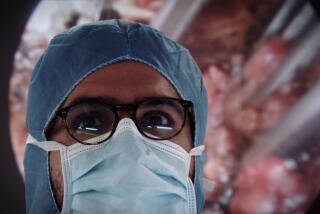How a human body becomes an exhibit
- Share via
Plastination of human bodies is an expensive and time-consuming process, according to the Institute of Plastination, a German firm that operates the human anatomy exhibitor Body Worlds.
When a body is put through the process, decomposition of the tissue is first stopped by formaldehyde or by freezing. The cadaver is then either dissected or sawed into slices, depending on how it will be preserved.
Frozen body fluids are replaced by acetone in a frigid (13 degrees below zero) acetone bath.
Most specimens, particularly bones and intestines, must be defatted in room-temperature acetone before plastination can begin. In a vacuum chamber, the acetone is squeezed out of the specimen and gradually replaced with plastic.
The plastic of choice for whole-organ specimens is usually silicone rubber, because it gives the specimens elasticity and a natural look. For cross-sections, a hard polymerized epoxy resin is used. The silicone rubber is gas-cured; the resin is heat-cured.
Because the weight of the water in the human body is about equal to the weight of the infused plastic, a plastinated body weighs about the same as a living one.
Each whole-body specimen requires up to 1,500 hours of work to prepare, usually over eight to 12 months. Because the process is so labor-intensive, costs can run as high as $60,000 per body.
Another human anatomy exhibitor, Premier Exhibitions, describes its preservation process in similar terms.

